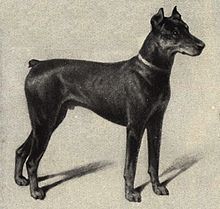Doberman Pinscher
The Doberman Pinscher (alternatively spelled Dobermann in many countries) or simply Doberman, is a breed of domestic dog originally developed around 1890 by Karl Friedrich Louis Dobermann. Doberman Pinschers are among the most common of pet breeds, and the breed is well known as an intelligent, alert, and loyal companion dog. Although once commonly used as guard dogs or police dogs, this is less common today.
In many countries, Doberman Pinschers are one of the most recognizable breeds, in part because of their actual roles in society, and in part because of media attention (see temperament). Careful breeding has improved the disposition of this breed, and the modern Doberman Pinscher is an energetic and lively breed suitable for companionship and family life.Although many Dobermans have been outdoor dogs, they are best suited to live indoors.
History
Doberman Pinschers were first bred in the town of Apolda, in the German state of Thuringia around 1890, following the Franco-Prussian War by Karl Friedrich Louis Dobermann. Dobermann served in the dangerous role of local tax collector, and ran the Apolda dog pound. With access to dogs of many breeds, he aimed to create a breed that would be ideal for protecting him during his collections, which took him through many bandit-infested areas. He set out to breed a new type of dog that, in his opinion, would be the perfect combination of strength, speed, endurance, loyalty, intelligence, and ferocity. Later, Otto Goeller and Philip Greunig continued to develop the breed to become the dog that is seen today.[citation needed]
The breed is believed to have been created from several different breeds of dogs that had the characteristics that Dobermann was looking for, including the German Pinscher, the Beauceron, the Rottweiler, the Thuringian Sylvan Dog, the Greyhound, the Great Dane, the Weimaraner, the German Shorthaired Pointer, the Manchester Terrier, the Old German Shepherd Dog, the American Pit Bull Terrier . The exact ratios of mixing, and even the exact breeds that were used, remain uncertain to this day, although many experts believe that the Doberman Pinscher is a combination of at least four of these breeds. The single exception is the documented crossing with the Greyhound and Manchester Terrier. It is also widely believed that the old German Shepherd gene pool was the single largest contributor to the Doberman breed. Philip Greunig'sThe Dobermann Pinscher (1939), is considered the foremost study of the development of the breed by one of its most ardent students. Greunig's study describes the breed's early development by Otto Goeller, whose hand allowed the Doberman to become the dog we recognize today.
After Dobermann's death in 1894, the Germans named the breed Dobermann-pinscher in his honor, but a half century later dropped the 'pinscher' on the grounds that this German word for terrier was no longer appropriate. The British did the same a few years later.
During World War II, the United States Marine Corps adopted the Doberman Pinscher as its official War Dog, although the Corps did not exclusively use this breed in the role.
 | ||||||||||||||||||||||
| A female Dobermann Pinscher with a docked tail and cropped ears. | ||||||||||||||||||||||
| Other names | Doberman | |||||||||||||||||||||
|---|---|---|---|---|---|---|---|---|---|---|---|---|---|---|---|---|---|---|---|---|---|---|
| Nicknames | Dobie Dobermann Dobynm (in some countries) | |||||||||||||||||||||
| Country of origin | Germany | |||||||||||||||||||||
| ||||||||||||||||||||||
| ||||||||||||||||||||||



No comments:
Post a Comment